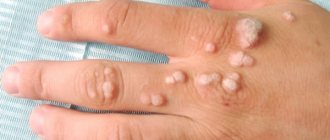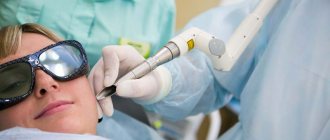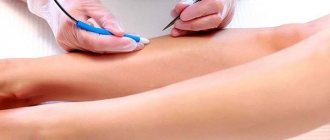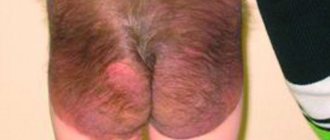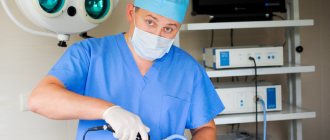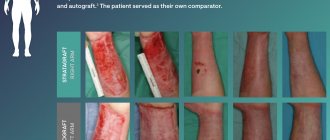Peyronie's disease is a disease of the male urogenital area, the characteristic symptom of which is the curvature of the penis during erection. In a calm state, the penis is no different from a healthy one, but when filled with blood, the curvature of the organ becomes noticeable.
If the penis is injured, irreversible changes occur in its protein membrane - scars that pull on neighboring tissues. Due to the formation of strands, curvature occurs. Injuries can be minor, so a man cannot always accurately determine what became the trigger for the development of the disease.
It is impossible to conservatively remove the cords, which means ridding a man of deformity. If the defect interferes with the quality of life, plastic surgery of the tunica albuginea of the penis will help.
What and how we treat
Many urological pathologies that develop after injuries, previous surgical interventions, or are congenital, significantly affect a person’s quality of life. Effective treatment of some of these diseases is only possible through surgery.
The operations we perform have proven effectiveness, and in some cases they are the gold standard of treatment. However, every operation cannot be performed according to a template, since almost every case in reconstructive surgery is unique. Proven diagnostic methods, extensive surgical experience and sensitive attention to the details of our medical problems allow us to choose the right tactics and predict the result.
Recovery
The longest recovery period is observed after phalloplasty. Hospital stay reaches 2 weeks. For 2 months physical activity and sex life are limited. This also applies to lipofilling. The remaining interventions allow sexual activity after 2 weeks.
- Injections of hyaluronic acid - visiting the sauna and taking hot baths is limited.
- Ligamentotomy requires wearing an extender.
- Moderate pain is relieved by taking non-steroidal anti-inflammatory drugs.
Surgeries on the penis
A number of operations help correct the appearance of the penis, and also prevent possible more serious complications. The following operations on the penis are performed in our clinic:
- Plastic surgery of the foreskin frenulum for a short frenulum
- Meatotomy and meatoplasty for dilation of the urethra
- Operation circumcision - surgical treatment of phimosis (narrowing of the foreskin) and paraphimosis
- Separation of adhesions (synechiae) of the foreskin of various categories of complexity
- Excision of genital warts from the external opening of the urethra, scaphoid fossa of the urethra
- AL-Ghorab type operations for priapism
- Operations to restore the skin of the penis
- Operations for oleogranulomas of the penis
Preparation, diagnostics
Preoperative examination includes:
- consultation with a urologist-andrologist;
- blood and urine tests;
- Ultrasound, CT, MRI of the penis, scrotum;
- ECG;
- chest x-ray;
- if necessary, uroflowrometry and urethrography;
- if necessary, cavernosography, cavernosometry, intracavernous test;
- consultations with an anesthesiologist and doctors of other specialties (as indicated).
You are allowed to have a light dinner 10–12 hours before the operation, and on the day of the intervention you are prohibited from eating, drinking and smoking. Be sure to tell your doctor if you have any drug allergies and regularly take dietary supplements and medications.
Surgeries to correct hypospadias and epispadias
Hypospadias is the abnormal development of the urethra. Specialists at the Andros Clinic perform more than 30 types of surgical operations for hypospadias. The exact method of surgical intervention is determined by the doctor after familiarizing himself with the patient’s medical history, as well as a thorough diagnosis. Below are a number of operations that are performed in the clinic for hypospadias:
- Meatotomy with glanuloplasty for capitate hypospadias
- Snodgrass operations for capitate, crown, distal trunk, proximal trunk, penoscrotal hypospadias
- Urethroplasty by Ducket, Koyanagi
- Two-stage hypospadias repair according to Bracka I, Bracka IIb, etc.
Who is corporoplasty indicated for?
According to medical recommendations, penile plastic surgery for Peyronie's disease is required for men if the angle of curvature of their penis in an erect state is more than 20 degrees. If the curvature is not so significant, you can do without surgery, since such severity of the defect does not interfere with sexual life. Although the last word always remains with the patient, and the operation can be performed on a man with any degree of deformity.
In case of serious impairment of erectile function due to Peyronie's disease, or with a high risk of impotence after surgery, the patient may be offered endophalloprosthetics with a plastic or inflatable three-component prosthesis with simultaneous modeling of the penis (plaque stretching) or corporoplasty with the application of a graft. It should also be said that corporoplasty is necessarily carried out together with circumcision.
To treat penis curvature and solve any other urological problems, you need to contact only professionals in order to maintain full urinary and sexual functions.
You will always receive qualified assistance at the Urology Clinic named after R. M. Fronshtein of the First Moscow State Medical University named after I.M. Sechenov (State Urology Center). If you experience symptoms of the disease, do not waste time and make an appointment with your doctor. September 14, 2020
Akopyan Gagik Nersesovich - urologist, oncologist, MD, doctor of the highest category, professor of the Department of Urology of the Federal State Autonomous Educational Institution of Higher Education First Moscow State Medical University named after. THEM. Sechenov
Clinic of Urology named after R. M. Fronshtein of the First Moscow State Medical University named after I.M. Sechenov invites you to an appointment with experienced urologists. To get an appointment with a qualified specialist, just fill out a short online application. Be sure to fill out all the fields, including a brief description of the symptoms (the “Information” column), specify whether you are interested in a secondary or primary appointment.
Pay attention to the “Attach file” button - it allows you to immediately send medical documents to the doctor in electronic form. This may include images, tests and other information that will be important to determine the diagnosis.
Still have questions? Call us by phone or! On a weekday, you can come for a consultation with a doctor within a few hours after filling out the online application. Do not delay visiting a specialist if you are concerned about your genitourinary health!
Operations for urethral strictures
The Andros Clinic occupies an expert niche in the problem of urethral stricture or pathological narrowing of the urethra. In particular, the leading specialist on this issue - urologist, andrologist, reconstructive surgeon Alexey Zhivov performs up to 100 reconstructive operations per year. The decision in favor of one or another surgical treatment depends on the extent and location of the urethral stricture. Below is a partial list of surgical interventions for urethral stricture of varying length and location.
- Transurethral resection of the area of urethral stricture, contracture of the urethro-vesical anastomosis of various categories of complexity
- Perineal urethrocutaneostomy of varying complexity
- Plastic surgery of urethral strictures of various lengths using the “anastomosis without intersection” method
- Stricture plastic surgery according to Turner-Warwick/Webster of various categories of complexity
- Augmentation plasty of strictures of various locations and extents
- Two-stage urethroplasty using oral mucosa or another graft according to Barbagli or Kelkarni of various locations and extents
Introduction of hyaluronic acid
The modern procedure allows you to quickly and permanently thicken and increase the size of the penis or its head. The technique involves injecting hyaluronic acid (a natural polysaccharide) under the fibrous membrane of the penis.
Progress of the procedure:
- Hair removal in the groin area.
- Applying an anesthetic to prevent discomfort.
- Injecting only those areas that need augmentation.
The result lasts up to 12 months or more. Hyaluronic acid is biocompatible with body cells, therefore it does not cause rejection or allergic reactions.
Operations on the scrotal organs
Scrotal surgery is generally not suitable for all patients. For example, one option for a testicular cyst or spermatocele is regular monitoring by a urologist. However, there are diseases that require urgent surgical intervention, for example, malignant testicular tumors. In any case, the decision to operate on the scrotal organs is made by the doctor after a thorough diagnosis, in particular, ultrasound of the scrotal organs.
- Excision of spermatocele and funicolocele
- Operation of Winckelmann, Bergmann and Lord for hydrocele (hydrocele)
- Subinguinal microsurgical varicocelectomy according to Marmar or Goldstein on one or both sides for varicocele
- Testicular prosthesis
Recovery period after frenulotomy
After completing the manipulations, the patient remains under the supervision of medical personnel for several more hours, after which, if there are no complications, he is sent home, recommending leaving the bandage on for at least 12 hours (or better yet, for one day). After this, it must be removed and the operated area kept open.
To prevent infection of the wound, he needs to regularly treat the seams with a solution of potassium permanganate or “green paint”. Elimination of pain symptoms in the first days is carried out by taking painkillers.
During the rehabilitation period, the patient should adhere to the following recommendations of the attending physician:
- carry out hygiene measures after each visit to the toilet and use an antiseptic solution prescribed by a doctor for this;
- take a course of antibiotics to prevent the development of purulent infections;
- during rapid healing, do not use fat-based ointments, as they can prolong the rehabilitation period;
- visit a urologist a week after the operation so that he can determine the need to remove the remaining threads, which should be completely resolved by this time.
In addition, during the recovery period you should avoid:
- physical activity and sports;
- visits to baths, saunas, swimming pools;
- taking baths;
- sexual intercourse and masturbation.
The latter is necessary in order to eliminate the risk of seams coming apart.
Ligamentotomy
This method has distinct advantages, including minimal risks of complications and immediate results. The length of the penis after surgery increases by 3-5 cm.
Indications:
- erection size no more than 12-16 cm;
- patient's wish
The essence of ligamentotomy is to make an incision into the tissue - the supporting ligament. As a result, separation from the pubic surface occurs, which leads to an increase in size.
The operation is performed under general anesthesia and lasts 30-60 minutes. The specialist makes an incision in the scrotum or pubic area, trims the ligament and fixes it in the desired position. To achieve a better result, the vacated space is filled with fatty tissue. This eliminates the possibility of adhesions and facilitates the rehabilitation process.
Causes
The pathogenesis of the disease is not fully understood. There are several theories that provoke penile curvature. It can be a consequence of two factors: congenital and acquired.
Congenital forms:
- heredity, the presence of gene abnormalities that are responsible for the synthesis of connective tissue protein collagen. Morphologically, the formation of connective tissue cords is noted in the cavernous bodies;
- abnormalities of organ development, short urethra, changes in the structure of the vascular network of the organ, hypoplasia of the tunica albuginea. The irregular shape of the penis is noticeable when it is filled with blood (erect state).
Purchased forms:
- injuries, bruises, organ fractures, which lead to the formation of hematomas and the development of inflammation. Without adequate therapeutic measures, the regeneration process leads to the formation of fibrous tissue of the cavernous bodies. Scar changes can thicken and cause deformation of the penis;
- autoimmune diseases. Cells of the immune system are able to attack their own tissues and cause damage, plaques and scars;
- drug therapy for diseases of the cardiovascular system, the use of beta blockers;
- drug treatment of impotence. Repeated administration of drugs injures the protein membrane of the organ and causes scarring;
- the use of various methods of stretching the penis, which provokes disruption of blood flow;
- vascular atherosclerosis, diabetes mellitus;
- connective tissue diseases: Dupuytren's contracture, Paget's disease, tympanosclerosis;
- hypo-, tocopherol vitamin deficiency, deficiency of microelements: calcium, magnesium;
- hypersecretion of the hormone serotonin;
- age-related changes in tissue elasticity.
